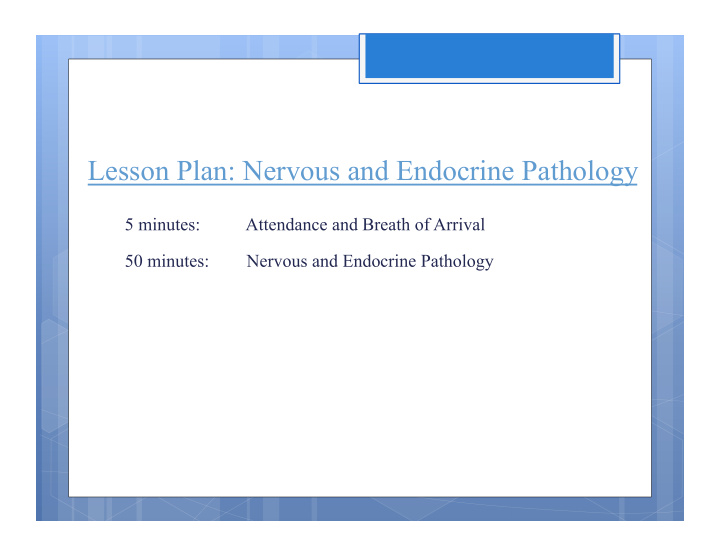



Lesson Plan: Nervous and Endocrine Pathology 5 minutes: Attendance and Breath of Arrival 50 minutes: Nervous and Endocrine Pathology
Classroom Rules Punctuality- everybody's time is precious: Be ready to learn by the start of class, we'll have you out of here on time Tardiness: arriving late, late return after breaks, leaving early The following are not allowed: Bare feet Side talking Lying down Inappropriate clothing Food or drink except water Phones in classrooms, clinic or bathrooms You will receive one verbal warning, then you'll have to leave the room.
Nervous and Endocrine Pathology
Nervous System Pathology (Werner Page 146) Chronic Degenerative Disorders Movement Disorders Alzheimer disease Dystonia Amyotrophic lateral Spasmodic torticollis sclerosis Parkinson disease Huntington disease Tremor Peripheral neuropathy
Nervous System Pathology (Werner Page 146) Infectious Disorders Psychiatric Disorders Encephalitis Addiction Herpes zoster Anxiety disorders Meningitis Attention deficit hyperactivity disorder Polio Autism spectrum disorder Postpolio syndrome Depression Eating disorders
Nervous System Pathology (Werner Page 146) Nervous System Disorders Nervous System Birth Defects Bell palsy Spina bifida Complex regional pain Cerebral Palsy syndrome Spinal cord injury Stroke Traumatic brain injury Trigeminal neuralgia
Nervous and Endocrine System Pathology (Werner Page 146 and 404) Endocrine System Other Nervous System Conditions Disorders Fibromyalgia Diabetes Headaches Hyperthyroidism Meneire disease Hypothyroidism Epilepsy Metabolic syndrome Sleep disorders Thyroid cancer Vestibular balance disorder
Nervous System Pathology Peripheral neuropathy Damage to peripheral nerves. Often the result of other underlying conditions, pathogens or toxic substances. Risks and Benefits Soothing touch may provide benefit if: Numbness doesn’t interfere with sensation of pain and pressure Pain or increased sensitivity don’t make massage painful It improves symptoms rather than exacerbating them Underlying conditions allow for bodywork
Nervous System Pathology Spasmodic torticollis (AKA: cervical dystonia) Most common form of dystonia. Involves unilateral contractions of neck rotators, usually sternocleidomastoid. Risks and Benefits Be aware of how medications affect the client Any bodywork that is comfortable to receive is safe Can help fatigue and reduce stress
Nervous System Pathology Postpolio syndrome Group of symptoms suffered by survivors of polio. Progressive muscular weakness. Risks Acute infection contraindicates massage Benefits Massage helps with strength, muscle tone, and fatigue
Nervous System Pathology Depression Group of mood disorders that can result in persistent feelings of sadness, guilt, and/or hopelessness. Risks and Benefits No risks unless the clients stops taking medication without medical supervision Massage is very beneficial for depression
Nervous System Pathology Spinal cord injury Damage to some or all of the spinal cord fibers. Caused by trauma, tumors, or bony growths. Risks Vulnerability to infection and other complications Numbness interferes accurate feedback from the client Autonomic dysreflexia Minor stimulus causing uncontrollable sympathetic responses such as a pounding headache, increased heart rate, flushing, sweating, and dangerously high blood pressure. Benefits Massage can weave together functioning and non-functioning parts of the body for a person with permanent nerve damage.
Nervous System Pathology Spinal Cord Injury
Nervous System Pathology Stroke (AKA: cerebrovascular accident, or brain attack) Damage to brain tissue. Caused by blockage in blood flow or by an internal hemorrhage. Risks and Benefits Risk of cardiovascular conditions is increased Caution near the carotid artery to avoid freeing a clot or plaque Massage can be very supportive and useful
Nervous System Pathology Stroke
Nervous System Pathology Fibromyalgia Chronic pain syndrome. Neuroendocrine disruption, sleep disorders, predictable patterns of tender points in muscles and other soft tissues. Risks and Benefits Beware of hypersensitivity and don’t overtreat Helps reduce pain, improve sleep, and add to quality of life
Nervous System Pathology Fibromyalgia
Nervous System Pathology Headaches One of the most common physical problems in the range of human experience. Pain caused by muscular tension, nerve irritation, vascular spasm and dilation, and chemical imbalances. Risks Infection or fever contraindicate massage Massage may exacerbate migraines Benefits Massage in between migraines may reduce frequency or intensity Tension-type headaches indicate massage
Nervous System Pathology Headaches
Nervous System Pathology Sleep disorders Collection of problems that make it difficult to get enough sleep or to wake up feeling rested and refreshed. Includes insomnia, sleep apnea, restless leg syndrome, narcolepsy, circadian rhythm disruption. Risks and Benefits No risks Sleep disorders indicate massage Massage can improve the quality of sleep and reduce mental and physical stresses that may interfere with sleep
Endocrine System Pathology Type 1 diabetes mellitus Autoimmune disorder resulting in hyperglycemia. Insulin deficiency due to destruction of insulin- producing beta cells in the pancreas. Caused by exposure to certain drugs or chemicals, or complications with certain types of infections. Type 2 diabetes mellitus Disorder resulting in hyperglycemia. Caused by pro-diabetes behavior and genetic predisposition. Can be controlled diet, exercise, and medication.
Endocrine System Pathology Risks If circulatory or urinary systems are impaired, client may not be able to adapt to rigorous massage Advanced disease can result in skin damage and ulcers, especially on the legs and feet Numbness can interfere with accurate feedback Massage could cause hypoglycemia (a drop in blood sugar) Benefits If diabetes is well managed and without contraindicating complications, the client should be able to enjoy the usual benefits
Nervous and Endocrine Pathology
Recommend
More recommend